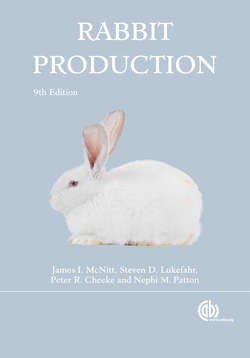Читать книгу Rabbit Production - James I McNitt - Страница 51
На сайте Литреса книга снята с продажи.
Sterility
ОглавлениеIn its natural environment the wild rabbit breeds during the spring and early summer and is barren during the fall and winter. During this barren period the doe’s ovaries become somewhat shriveled and inactive and fail to produce normal egg cells; bucks may fail to produce sperm, or the sperm may lack motility or be abnormally developed. In creating the domestic rabbit, humans have shortened the barren period somewhat. Its duration and intensity vary considerably. Some does and bucks are fertile throughout the year and for successive years. Others are not fertile for extended periods. When does are out of production for an extended time, it is more difficult to get them to conceive; but if the herd has received proper care, a large percentage of both does and bucks should be over the barren period in a short time. In extreme cases, however, the period may last four to five months. Usually, such a prolonged period occurs in an area where excessive temperatures have prevailed, especially when unseasonably or excessively high temperatures occur and continue for some time or when the high temperatures are associated with drought conditions. Indications are that sperm production of the bucks is more likely to be impaired by these high temperatures than ovulation in the does, but both sexes can be affected.
Another cause for prolonged sterile periods may be that the ration has not been properly balanced or that the proper amount of feed wasn’t used to keep the rabbits in desired breeding condition. While an animal is molting, the development of a new coat may tax its vitality, and conception may be delayed. Occasionally an animal is permanently infertile and should be culled.
Because there is so much variation among does and bucks in regard to the regularity of breeding, the rabbit breeder may well give considerable attention to overcoming this factor through proper selection of breeding stock. Breeding stock should be selected from parents that produce regularly. Attempts to increase production during the sterile period by the use of vitamins and other feed supplements have not been effective.
During the late autumn and early winter, when the percentage of does that conceive is below that of the spring and summer, the birth weight of the young may be below normal, litters may contain fewer individuals, and the does may neglect their young or the young may be unable to nurse. A decrease in conception in the winter may be caused by inadequate feeding. In the cold of winter in unheated rabbitries, the rabbits use more of their daily ration to produce heat to keep warm. Therefore, less energy is available for reproductive processes. To offset this increased body heat demand, the daily feed allotment to does should be increased by about 25 to 50 percent in the winter.
One of the most important factors that influences seasonal fertility is the lighting program. In the wild, the rabbit is a seasonal breeder; this pattern is possibly regulated both by temperature and by light. During the fall, as day length decreases, a light-sensitive gland, the pineal gland, detects the decrease in light and decreases the secretion of certain reproductive hormones by the pituitary gland at the base of the rabbit’s brain. By maintaining a longer day length in the rabbitry through the use of artificial lights, you may be able to prevent the winter decline in reproduction. A lighting period of 16 hours per day seems adequate in most regions; the length of the lighting period should be as long as the longest day in your region. This is the principle used in the poultry industry to keep birds laying in the winter. Hand switching of the lights is too unreliable and irregular to give good results. An electric timer should be used to regulate the day length. Note that in the winter, extra hours of light will be required in the morning as well as in the evening. A great deal more research is needed to elucidate the role of environmental factors such as temperature and light in controlling rabbit production.
Young does and bucks may be sexually immature, while other does and bucks may be too old, having passed their period of usefulness. The proper age for rabbits to be put into production was discussed earlier, and the animals may be retained in the breeding herd as long as they maintain good physical condition and produce satisfactory litters. This may be until they are 2 ½ to 3 years old. There is wide variation, and some individuals may reproduce satisfactorily for four years or more. However, in some commercial herds, up to 100 percent of the does may be replaced each year.
A high culling rate may be desirable to continually upgrade the herd. If proper selection procedures are used, each doe that is culled can be replaced by a doe of higher genetic quality.
